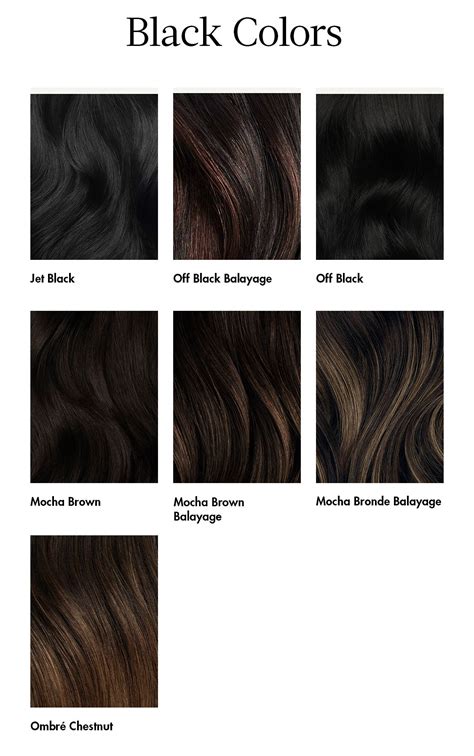With over 3 billion people around the world having black hair, it’s no surprise that there’s a wide range of shades to choose from. But what if you’re looking for the blackest hair color possible?

This in-depth guide will explore the various options for achieving the darkest hair color, highlighting the pros and cons of each method. From natural dyes to synthetic hair colorants, we’ll cover everything you need to know about getting the blackest hair color.
Natural Black Hair Color
Jet Black: Jet black is the darkest natural hair color, with a hue that’s almost indistinguishable from the darkest black paint. It’s most commonly found in people of African or Asian descent and is characterized by its lack of any noticeable shine or highlights.
Blue-Black: Blue-black hair is a slightly less intense shade of black with hints of blue undertones. It’s often seen in people of East Asian descent and can give the hair a subtle iridescent effect.
Brown-Black: Brown-black hair is a dark brown shade with very little red undertones. It’s common in people of European or Middle Eastern descent and can appear almost black in certain lighting conditions.
Synthetic Black Hair Colorants
Permanent Hair Color: Permanent hair color is a chemical treatment that alters the hair’s natural pigment, resulting in a long-lasting color change. Black is one of the most popular permanent hair color choices and can be achieved using a variety of different hair dye brands.
Semi-Permanent Hair Color: Semi-permanent hair color is a less intense form of permanent hair color that fades gradually over time, typically lasting for 6-8 weeks. It’s a good option for people who want to try a darker shade of black without committing to a full-blown permanent color.
Temporary Hair Color: Temporary hair color is a quick and easy way to try out a darker hair color without any long-term commitment. It’s typically applied using a hairspray or mousse and washes out after one or two shampoos.
Pros and Cons of Black Hair Color
Pros:
- Adds depth and mystery to the hair
- Can make facial features appear brighter and more defined
- Complements a wide range of skin tones
- Can be achieved using a variety of methods, from natural dyes to synthetic hair colorants
Cons:
- Can be difficult to maintain, as roots will grow in and show a lighter color
- Can fade or lighten over time, especially if exposed to sunlight or heat styling
- May require more frequent touch-ups to keep the color looking fresh
Achieving the Blackest Hair Color
Natural Dyes:
- Indigo: Indigo is a natural plant-based dye that has been used for centuries to create dark blue-black hair. It’s known for its ability to provide rich, long-lasting color.
- Henna: Henna is another natural plant-based dye that can be used to achieve a dark brown-black hair color. It’s also known for its hair conditioning properties.
Synthetic Hair Colorants:
- Black hair dye: There are a wide variety of black hair dyes available, both permanent and semi-permanent. They come in various shades to match different natural hair colors and undertones.
- Demi-black hair dye: Demi-black hair dye is a milder form of permanent hair dye that can provide a less intense black color. It’s a good option for people who want to achieve a subtle black shade.
Tips for Maintaining Black Hair Color
- Use color-safe shampoo and conditioner: These products are designed to preserve the color and prevent fading.
- Limit heat styling: Heat can damage the hair and cause color to fade more quickly.
- Protect hair from the sun: UV rays can break down hair color, so wear a hat or scarf when outdoors for extended periods of time.
- Touch up roots regularly: As your hair grows, your roots will start to show your natural hair color. Touch up your roots every 4-6 weeks to maintain your black hair color.
Frequently Asked Questions
1. What is the darkest natural hair color?
Jet black is the darkest natural hair color.
2. What is the difference between permanent and semi-permanent hair color?
Permanent hair color alters the hair’s natural pigment and lasts until the hair grows out. Semi-permanent hair color fades gradually over time, typically lasting for 6-8 weeks.
3. Can I achieve black hair color with natural dyes?
Yes, you can achieve black hair color using natural dyes such as indigo and henna. However, it’s important to note that natural dyes can produce slightly different results depending on your natural hair color and undertones.
4. How often should I touch up my black hair color?
You should touch up your black hair color every 4-6 weeks to maintain the color and cover up any visible roots.
5. Can black hair color damage my hair?
Synthetic black hair colorants can contain chemicals that damage the hair, especially if used excessively. It’s important to follow the manufacturer’s instructions carefully and use color-safe hair care products to minimize damage.
6. Is black hair color suitable for all skin tones?
Black hair color complements a wide range of skin tones, but it’s especially flattering for people with warm or neutral undertones.
7. Can I use black hair color on bleached hair?
Yes, you can use black hair color on bleached hair, but it’s important to note that the color may not be as intense as on natural hair. It’s also important to do a strand test first to ensure that the hair can withstand the bleaching and coloring process without damage.
8. Are there any health risks associated with black hair color?
Some synthetic black hair colorants contain chemicals that can be harmful to health, such as ammonia and parabens. It’s important to read the labels carefully and choose products that are free of these harmful ingredients.
